Blog
June 12, 2014
Cameras for conservation – the Ruaha Carnivore Project’s camera trap program.
By Ryan Green, Travel Writer.
The Ruaha Carnivore Project has initiated a study using camera traps to gather crucial data on the movements of predators within Ruaha. These cameras provide an excellent, non-intrusive way of monitoring wildlife, and sometimes they can be used for entirely different reasons.
Amy Dickman, director of the Ruaha Carnivore Project, (RCP) has been co-supervising PhD student Jeremy Cusack, who has set up the initiative with Trevor Jones from the Udzungwa Elephant project with assistance from the RCP team.
The camera-traps have been set out across the Ruaha ecosystem, and the aim of the project is to learn more about the diversity and relative distribution of carnivores and other wildlife in this critically important landscape. There is one permanent camera-trap grid stationed close to Msembe, the Ruaha National Park headquarters, and that has been revealing some wonderful images of carnivores. These include the elusive caracal, as well as some great photos of cheetahs, which are typically very hard to capture on camera-traps due to their wide-ranging nature. In addition, images of lion, leopard, serval, and three termite-eating mammals (aardvark, aardwolf and bat-eared fox) have been captured.
“These images provide invaluable scientific data for us on species’ occurrence and habitat selection, but are also fascinating to see.” Says Amy. The camera traps have been very productive so far – “ We have conducted initial camera-trapping across the landscape, and one of our Tanzanian research assistants will be using these data for his MSc, while we have had over 1500 carnivore sightings reported to us thus far. We will share these data with the Tanzanian authorities and other stakeholders, so we can help them develop the most appropriate conservation and management strategies for these globally important large carnivore populations.”
It is estimated that Ruaha holds approximately 10% of Africa’s lion population, meaning that this, and other studies associated with it, might well hold the key to the survival of the species in an increasingly crowded continent that we share with them.
Thus far, the RCP has gathered some fantastic images of not only the large predators such as lions that are their main branch of study so as to reduce the causes of human/wildlife conflict in the region, but also some of the lesser seen, but equally fascinating creatures that inhabit the park. In addition, the RCP and Lion Guardian Daudi were able to play a vital part in helping a local community track down a young disabled boy who had gone missing in the bush.
Lion Guardians are an innovative program initiated by the global big-cat conservation NGO Pantera in Kenya, and are being trialled in Ruaha by the RCP. This approach centres on training and employing the local lion-hunters as conservationists, therefore giving them a tangible benefit from carnivore presence. Now in its second year, the Lion Guardians program has proved to be extremely beneficial in harmonising human/lion coexistence in the area around Ruaha, and sometimes in unexpected ways:
Lion Guardians help find a disabled boy in the bush
Livestock become lost in the bush relatively often in the study area, and it is part of the role of Lion Guardians to help the community by trying to find them and avoid depredation. In April, the Lion Guardians played an extra-important role when a disabled boy became lost in the bush, and they teamed up with other young men to help find him. The boy was eventually found after spending a night alone in the bush – and interestingly, RCP’s camera traps captured some photos of the search, including photos of the lost boy, the search party, and also a lost cow, which was found and returned by Daudi, one of the longest-standing Ruaha Lion Guardians. These kinds of community actions are very important, as they demonstrate a clear benefit to local people from the presence of the Lion Guardians and the wider RCP project.
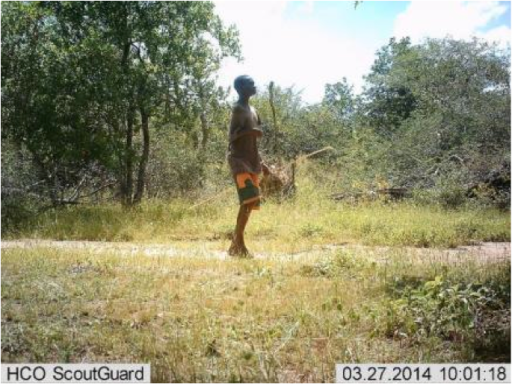
Camera-trap photo of the lost boy
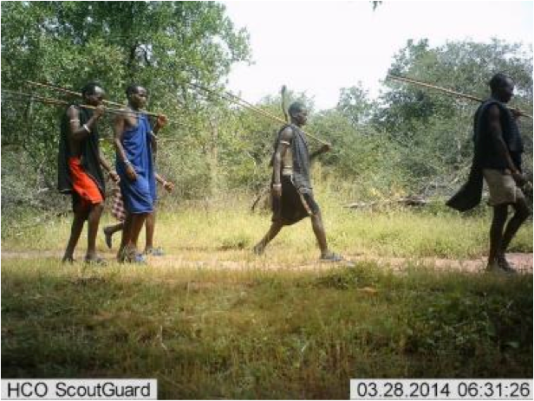
Camera-trap image of one of the search parties looking for the boy
Image of a lost cow, which was found by Ruaha Lion Guardian Daudi, and was returned safely to its owner before it could be attacked by a carnivore
A caracal, which is a rarely seen, medium-sized cat. The presence of smaller predators is an indicator of a healthily functioning ecosystem that contains an abundance of small prey species, from rodents to spurfowl and lagomorphs, which are a principal part of the caracal’s diet.
A large, mature male leopard captured on camera. Male leopards typically have territories that overlap with that of several females. The presence of this male would then be a good reason to expand the trapping grid in search of females, which could be indentified by their unique spot-patterns.
Two cheetahs, which are rarely captured on the camera-traps, as they have large ranges, as opposed to territories. Prey species such as impala and Grant’s gazelles captured in other images would explain their presence. Typically cheetahs, when seen in a pair like this, would be a mother and sub-adult cub, or a coalition of two males. Judging by the images, they appear healthy and have fed recently.
A lioness walking through the Park at night- although not an entirely useful image to identify an individual, this image, along with the imbedded GPS data in the camera, gives the researchers data on lion prides’ territories.
A serval, another of the elusive smaller cats in the Ruaha ecosystem as they are hard to spot due to their retiring nature and diminutive size. The presence of smaller carnivores such as these are indicators of a healthily functioning ecosystem.
An aardwolf – a small member of the dog family that relies heavily upon termites for its diet. Extremely shy and nocturnal by nature, aardwolves live in burrows and are difficult to monitor and study- the cameras thus provide valuable information pertaining to their presence.
A bat-eared fox – a very pretty member of the dog family, which uses its large ears to locate underground prey.
An aardvark – a fascinating animal that is hard to spot in the Ruaha area, as it is largely nocturnal, active usually in the darkest hours of the night.
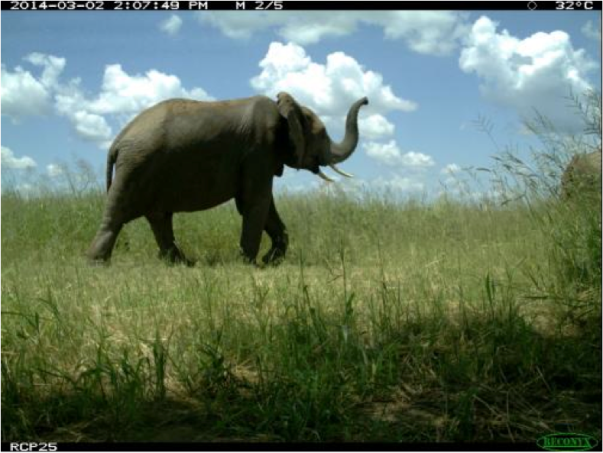
An elephant, sniffing the air as it walks along
A group of Grant’s gazelle – one of the favoured prey items of the cheetahs captured above!
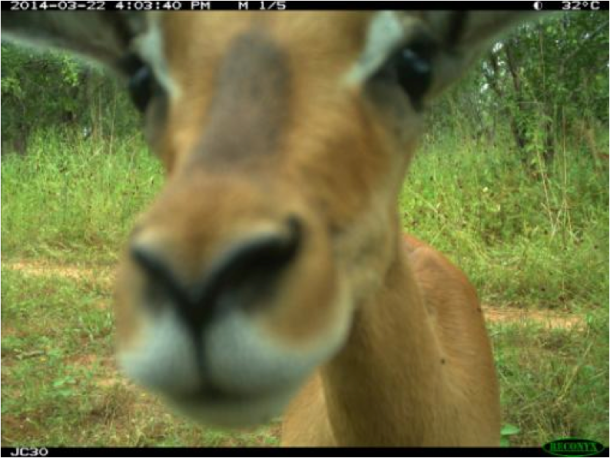
A curious impala getting a closer look at one of the camera-traps!
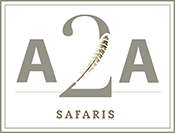
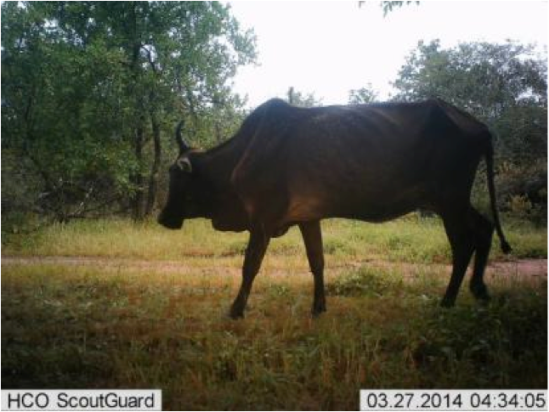
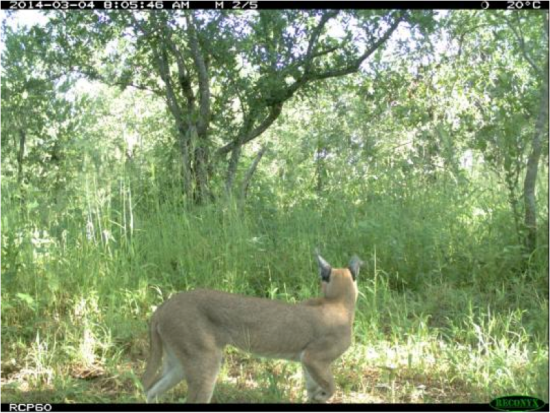
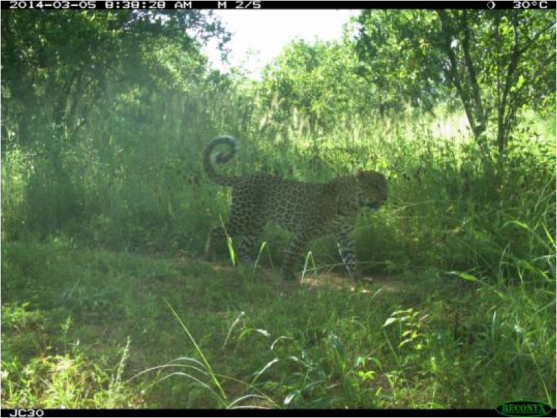

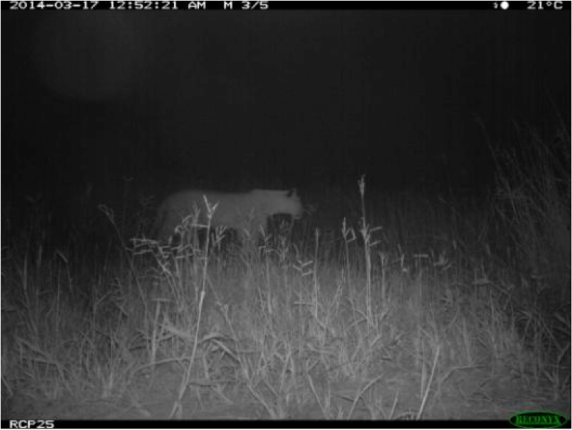
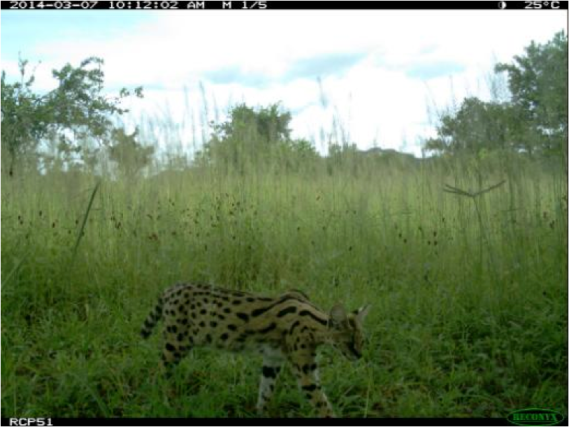
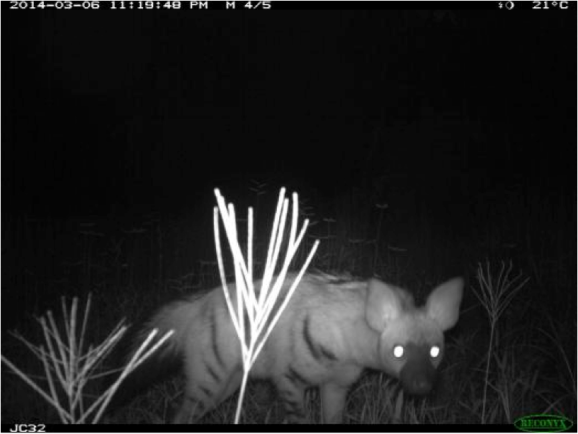
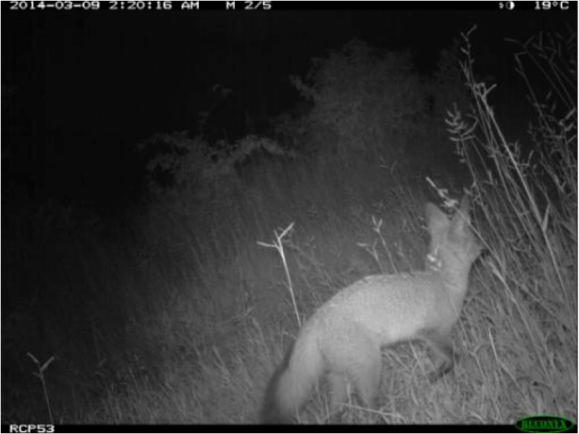
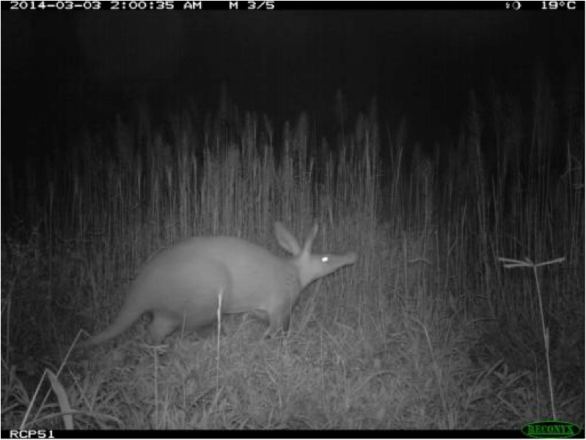
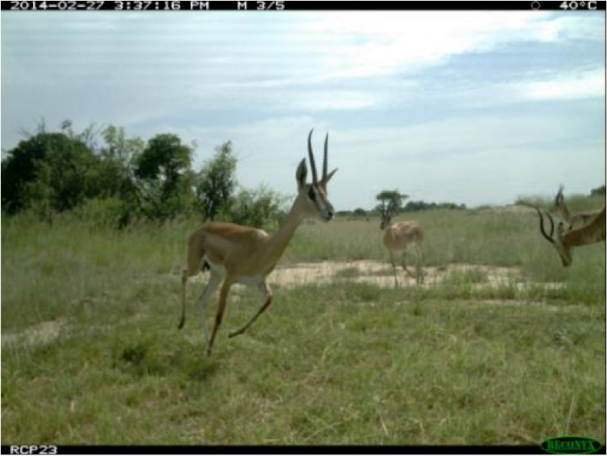
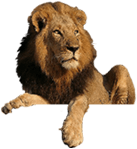



































Add comment
By Ryan Green, Travel Writer.
The Ruaha Carnivore Project has initiated a study using camera traps to gather crucial data on the movements of predators within Ruaha. These cameras provide an excellent, non-intrusive way of monitoring wildlife, and sometimes they can be used for entirely different reasons.
Amy Dickman, director of the Ruaha Carnivore Project, (RCP) has been co-supervising PhD student Jeremy Cusack, who has set up the initiative with Trevor Jones from the Udzungwa Elephant project with assistance from the RCP team.
The camera-traps have been set out across the Ruaha ecosystem, and the aim of the project is to learn more about the diversity and relative distribution of carnivores and other wildlife in this critically important landscape. There is one permanent camera-trap grid stationed close to Msembe, the Ruaha National Park headquarters, and that has been revealing some wonderful images of carnivores. These include the elusive caracal, as well as some great photos of cheetahs, which are typically very hard to capture on camera-traps due to their wide-ranging nature. In addition, images of lion, leopard, serval, and three termite-eating mammals (aardvark, aardwolf and bat-eared fox) have been captured.
“These images provide invaluable scientific data for us on species’ occurrence and habitat selection, but are also fascinating to see.” Says Amy. The camera traps have been very productive so far – “ We have conducted initial camera-trapping across the landscape, and one of our Tanzanian research assistants will be using these data for his MSc, while we have had over 1500 carnivore sightings reported to us thus far. We will share these data with the Tanzanian authorities and other stakeholders, so we can help them develop the most appropriate conservation and management strategies for these globally important large carnivore populations.”
It is estimated that Ruaha holds approximately 10% of Africa’s lion population, meaning that this, and other studies associated with it, might well hold the key to the survival of the species in an increasingly crowded continent that we share with them.
Thus far, the RCP has gathered some fantastic images of not only the large predators such as lions that are their main branch of study so as to reduce the causes of human/wildlife conflict in the region, but also some of the lesser seen, but equally fascinating creatures that inhabit the park. In addition, the RCP and Lion Guardian Daudi were able to play a vital part in helping a local community track down a young disabled boy who had gone missing in the bush.
Lion Guardians are an innovative program initiated by the global big-cat conservation NGO Pantera in Kenya, and are being trialled in Ruaha by the RCP. This approach centres on training and employing the local lion-hunters as conservationists, therefore giving them a tangible benefit from carnivore presence. Now in its second year, the Lion Guardians program has proved to be extremely beneficial in harmonising human/lion coexistence in the area around Ruaha, and sometimes in unexpected ways:
Lion Guardians help find a disabled boy in the bush
Livestock become lost in the bush relatively often in the study area, and it is part of the role of Lion Guardians to help the community by trying to find them and avoid depredation. In April, the Lion Guardians played an extra-important role when a disabled boy became lost in the bush, and they teamed up with other young men to help find him. The boy was eventually found after spending a night alone in the bush – and interestingly, RCP’s camera traps captured some photos of the search, including photos of the lost boy, the search party, and also a lost cow, which was found and returned by Daudi, one of the longest-standing Ruaha Lion Guardians. These kinds of community actions are very important, as they demonstrate a clear benefit to local people from the presence of the Lion Guardians and the wider RCP project.
Camera-trap photo of the lost boy
Camera-trap image of one of the search parties looking for the boy
Image of a lost cow, which was found by Ruaha Lion Guardian Daudi, and was returned safely to its owner before it could be attacked by a carnivore
A caracal, which is a rarely seen, medium-sized cat. The presence of smaller predators is an indicator of a healthily functioning ecosystem that contains an abundance of small prey species, from rodents to spurfowl and lagomorphs, which are a principal part of the caracal’s diet.
A large, mature male leopard captured on camera. Male leopards typically have territories that overlap with that of several females. The presence of this male would then be a good reason to expand the trapping grid in search of females, which could be indentified by their unique spot-patterns.
Two cheetahs, which are rarely captured on the camera-traps, as they have large ranges, as opposed to territories. Prey species such as impala and Grant’s gazelles captured in other images would explain their presence. Typically cheetahs, when seen in a pair like this, would be a mother and sub-adult cub, or a coalition of two males. Judging by the images, they appear healthy and have fed recently.
A lioness walking through the Park at night- although not an entirely useful image to identify an individual, this image, along with the imbedded GPS data in the camera, gives the researchers data on lion prides’ territories.
A serval, another of the elusive smaller cats in the Ruaha ecosystem as they are hard to spot due to their retiring nature and diminutive size. The presence of smaller carnivores such as these are indicators of a healthily functioning ecosystem.
An aardwolf – a small member of the dog family that relies heavily upon termites for its diet. Extremely shy and nocturnal by nature, aardwolves live in burrows and are difficult to monitor and study- the cameras thus provide valuable information pertaining to their presence.
A bat-eared fox – a very pretty member of the dog family, which uses its large ears to locate underground prey.
An aardvark – a fascinating animal that is hard to spot in the Ruaha area, as it is largely nocturnal, active usually in the darkest hours of the night.
An elephant, sniffing the air as it walks along
A group of Grant’s gazelle – one of the favoured prey items of the cheetahs captured above!
A curious impala getting a closer look at one of the camera-traps!